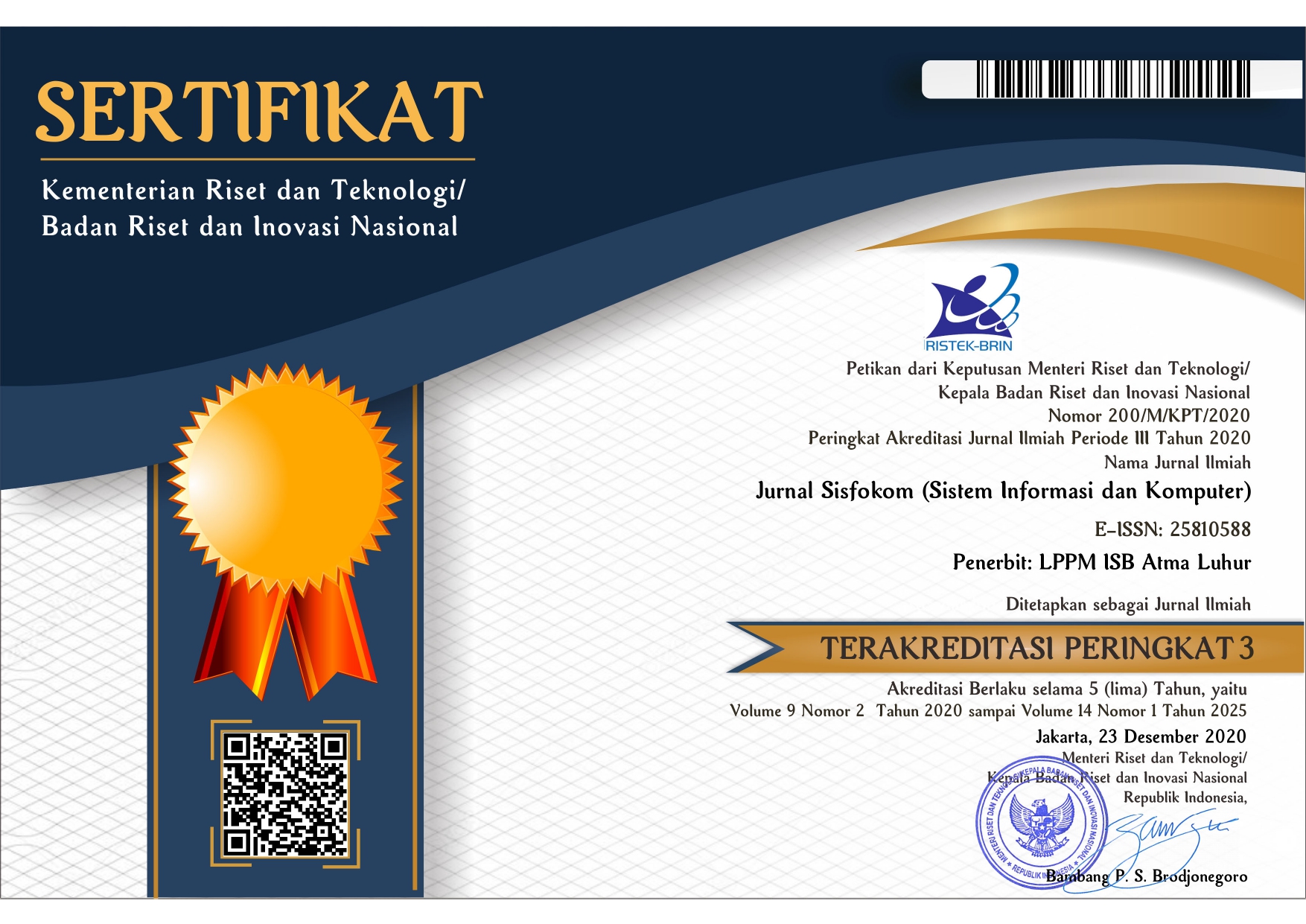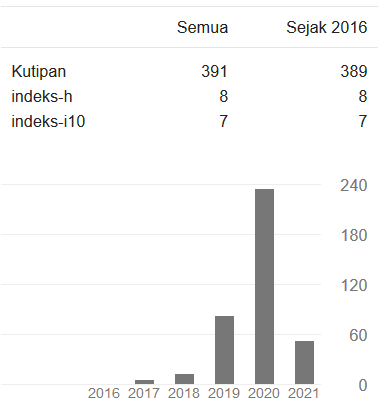Optimizing Procurement Efficiency by Implementing K-Means and Random Forest in Kopegtel Samarinda’s Warehouse System
DOI:
https://doi.org/10.32736/sisfokom.v13i3.2288Keywords:
CRISP-DM, K-Means, Procurement, Random Forest, WarehouseAbstract
Procurement is a company’s activity to purchase goods or equipment needed in operations. In the management process, a procurement management system is often used to facilitate this management, such as at CV Indocitra Multi Artha, which uses the “Sistem Warehouse Kopegtel Samarinda.” The system provides significant assistance to the company, but large requests can be overwhelming to be handled by the manager and can cause an overload information problem. Research was conducted to deal with these problems by implementing a data mining algorithm as a procurement recommendation system. K-means and Random Forest algorithms were chosen as methods for the research. The algorithm is processed within two critical steps, first by K-Means to get cluster data and then by predicting it with Random Forest to get a recommendation for whether the object should be bought or not. Hyperparameter tuning was performed to optimize the model’s performance, yielding an F1-Score of 86.95%, representing the balance between precision and recall, and an ROC AUC value of 82.34%. These substantial metric outcomes indicate that the model can provide practical recommendationsReferences
G. Sugiyanto et al., Manajemen Sistem Informasi, 1st ed. Padang: Global Eksekutif Teknologi, 2022.
D. García-Barrios, K. Palomino, E. García-Solano, and A. Cuello-Quiroz, “A Machine Learning Based Method for Managing Multiple Impulse Purchase Products: an Inventory Management Approach,” J. Eng. Sci. Technol. Rev., vol. 14, no. 1, pp. 25–37, 2021, doi: 10.25103/jestr.141.02.
Z. Fayyaz, M. Ebrahimian, D. Nawara, A. Ibrahim, and R. Kashef, “Recommendation Systems: Algorithms, Challenges, Metrics, and Business Opportunities,” Appl. Sci., vol. 10, no. 21, pp. 1–20, 2020, doi: 10.3390/app10217748.
J. M. Spreitzenbarth, C. Bode, and H. Stuckenschmidt, “Artificial Intelligence and Machine Learning in Purchasing and Supply Management: a Mixed-methods Review of the State-of-the-art in Literature and Practice,” J. Purch. Supply Manag., vol. 30, no. 1, p. 100896, 2024, doi: 10.1016/j.pursup.2024.100896.
S. S. Yassin and Pooja, “Road Accident Prediction and Model Interpretation Using a Hybrid K-means and Random Forest Algorithm Approach,” SN Appl. Sci., vol. 2, no. 9, pp. 1–13, 2020, doi: 10.1007/s42452-020-3125-1.
H. A. Elzeheiry, S. Barakat, and A. Rezk, “Different Scales of Medical Data Classification Based on Machine Learning Techniques: a Comparative Study,” Appl. Sci., vol. 12, no. 2, p. 919, Jan. 2022, doi: 10.3390/app12020919.
R. W. S. B. Brahmana, F. A. Mohammed, and K. Chairuang, “Customer Segmentation Based on RFM Model Using K-Means, K-Medoids, and DBSCAN Methods,” Lontar Komput. J. Ilm. Teknol. Inf., vol. 11, no. 1, p. 32, 2020, doi: 10.24843/lkjiti.2020.v11.i01.p04.
A. Pajankar and A. Joshi, Introduction to Machine Learning with Scikit-learn. Berkeley, CA: Apress, 2022. doi: 10.1007/978-1-4842-7921-2_5.
V. Z. Kamila and E. Subastian, “KNN vs Naive Bayes Untuk Deteksi Dini Putus Kuliah Pada Profil Akademik Mahasiswa,” J. Rekayasa Teknol. Inf., vol. 3, no. 2, pp. 116–121, 2019, doi: 10.30872/jurti.v3i2.3097.
V. Z. Kamila, E. Subastian, and Rosmasari, “KNN and Naive Bayes for Optional Advanced Courses Recommendation,” in 2019 International Conference on Electrical, Electronics and Information Engineering (ICEEIE), Oct. 2019, pp. 306–309. doi: 10.1109/ICEEIE47180.2019.8981450.
IBM, IBM SPSS Modeller CRISP-DM Guide, 18.4. New York, NY: IBM, 2023. [Online]. Available: https://www.ibm.com/docs/it/SS3RA7_18.4.0/pdf/ModelerCRISPDM.pdf
C. Schröer, F. Kruse, and J. M. Gómez, “A Systematic Literature Review on Applying CRISP-DM Process Model,” Procedia Comput. Sci., vol. 181, no. 2019, pp. 526–534, 2021, doi: 10.1016/j.procs.2021.01.199.
J. L. Nielson et al., “Statistical Guidelines for Handling Missing Data in Traumatic Brain Injury Clinical Research,” J. Neurotrauma, vol. 38, no. 18, pp. 2530–2537, 2021, doi: 10.1089/neu.2019.6702.
R. Rodríguez et al., “Water-quality Data Imputation With a High Percentage of Missing Values: a Machine Learning Approach,” Sustain., vol. 13, no. 11, pp. 1–17, 2021, doi: 10.3390/su13116318.
F. Sigrist, “A Comparison of Machine Learning Methods for Data with High-Cardinality Categorical Variables,” Digit. Gov. Res. Pract., pp. 1–8, 2023, doi: 10.48550/arXiv.2307.02071.
M. J. Zaki and M. J. Meira, Data Mining and Analysis: Fundamental Concepts and Algorithms, 2nd ed. Cambridge: Cambridge University Press, 2020.
Islamiyah, P. L. Ginting, N. Dengen, and M. Taruk, “Comparison of Priori and FP-Growth Algorithms in Determining Association Rules,” ICEEIE 2019 - Int. Conf. Electr. Electron. Inf. Eng. Emerg. Innov. Technol. Sustain. Futur., pp. 320–323, 2019, doi: 10.1109/ICEEIE47180.2019.8981438.
K. Golalipour, E. Akbari, S. S. Hamidi, M. Lee, and R. Enayatifar, “From Clustering to Clustering Ensemble Selection: a Review,” Eng. Appl. Artif. Intell., vol. 104, no. November 2020, p. 104388, 2021, doi: 10.1016/j.engappai.2021.104388.
M. Arhami and M. Nasir, Data Mining - Algoritma dan Implementasi. Yogyakarta: Andi Offset, 2020.
Downloads
Published
Issue
Section
License
The copyright of the article that accepted for publication shall be assigned to Jurnal Sisfokom (Sistem Informasi dan Komputer) and LPPM ISB Atma Luhur as the publisher of the journal. Copyright includes the right to reproduce and deliver the article in all form and media, including reprints, photographs, microfilms, and any other similar reproductions, as well as translations.
Jurnal Sisfokom (Sistem Informasi dan Komputer), LPPM ISB Atma Luhur, and the Editors make every effort to ensure that no wrong or misleading data, opinions or statements be published in the journal. In any way, the contents of the articles and advertisements published in Jurnal Sisfokom (Sistem Informasi dan Komputer) are the sole and exclusive responsibility of their respective authors.
Jurnal Sisfokom (Sistem Informasi dan Komputer) has full publishing rights to the published articles. Authors are allowed to distribute articles that have been published by sharing the link or DOI of the article. Authors are allowed to use their articles for legal purposes deemed necessary without the written permission of the journal with the initial publication notification from the Jurnal Sisfokom (Sistem Informasi dan Komputer).
The Copyright Transfer Form can be downloaded [Copyright Transfer Form Jurnal Sisfokom (Sistem Informasi dan Komputer).
This agreement is to be signed by at least one of the authors who have obtained the assent of the co-author(s). After submission of this agreement signed by the corresponding author, changes of authorship or in the order of the authors listed will not be accepted. The copyright form should be signed originally, and send it to the Editorial in the form of scanned document to sisfokom@atmaluhur.ac.id.






